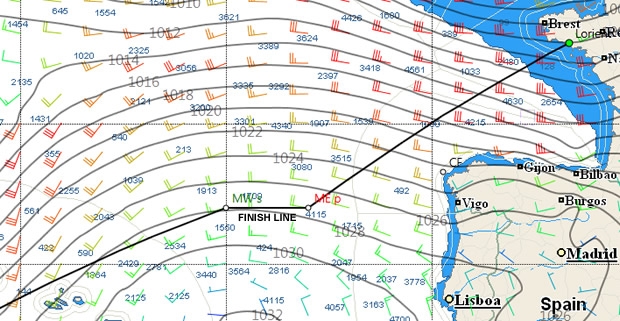Transat B to B course shortened
The Race Committee for the IMOCA 60s' Transat B to B, in agreement with the organiser of the event and the relevant authorities, race committee and jury, has decided to shorten course in their race. The mandatory safety gate will now serve as the finish line for the event.
Ending the Transat B to B at the safety gate, which spans 42°N between 16-20°W (ie 325-500 miles due west of Vigo, Spain, Race Director Jacques Caraes has opted for safety given the exceptional weather conditions, even for winter in the North Atlantic. In particular it is the wind strength expected overnight on Thursday, which has convinced the race organisers to make this decision. The forecast is indicating winds exceeding 50 knots and gusting to 60-70 knots, along with a rapid veering from the southwest into the northwest creating a potentially boat-breaking cross seas and average wave heights of 8m as the fleet approached the continental shelf, where the seabed rises from 4,000 to 150m creating an even more chaotic sea state.
The course amendment was sent to the competitors today at 1900 (UTC) through application of RRS 32.1 (b) and RRS 32.2 (c) (no sound or visual signal, competitors are informed through the present amendment. This changesthe rules 32.1 and 32.2.):
- The course of the Transat B to B is shortened to the safety gate (amendment n°4).
- The finish line is defined between geographical point 42°00N – 020°00W to be left to starboard and geographical point 42°00N – 016°00W to be left to port.
- The finish line of the shortened course shall be crossed in the North-South direction.
- The finish order of the boats will be established with the Iridium positions picked up by Race Committee when boats cross this line.
- Competitors will keep track of their crossing the line on their navigation software for the Race Committee's and the Jury's use.
Article 10.3.2 of the Notice of Race remains applicable:
- The boat's presence is compulsory in Lorient from the finish until the announcement of the results - due on 22 December.
Gaétan Gouérou, organiser of the Transat B to B commented: “I wholeheartedly back the decision by the race committee to shorten course at the safety gate, off the Spanish coast. It is the result of some exceptional weather conditions and testifies to the spirit which has presided over the organisation of this race: to give future Vendée Globe sailors the opportunity to get practice racing solo, enabling some of them to qualify for the round the world race. In this way, the Transat B to B has already achieved its objectives and the sailors themselves have testified to this on several occasions. The extremely varied conditions encountered since the start, have enabled everyone to gauge their level of preparation for the Vendée Globe, to get the measure of their competitors. I'd like to thank the sailors and those involved in the organisation of the event. A decision of this kind is never easy to make, but whatever happens, we'll do everything we can to ensure that the party is a great one in Lorient…”
The first boat, Francois Gabart's MACIF is due to cross the safety gate/finish line later this evening.
Mike Golding commented: "You do still gybe [once through the line] but what they are saying is that you can slow the boat right down through the bad bit and then start sailing again. That is what I'll do, I'll race through the line as quick as I can and then I'll let the mainsail down, kite down and just go with the headsail.
"I have never known this to happen before. At the end of the day, I sort of understand, when you race, with the pressure of the race, you might do things that you wouldn't normally do. This is an exceptional storm. I haven't seen many storms quite like this one. Anything that makes things safe is good by me, but from a sailor's perspective it is tough."
When pushed on whether the sailor's and boat's safety should be down to the teams themselves, rather than the race organisers, Golding agreed. "It is true that the bottom line for safety comes down to each skipper, but someone's desire to win will perhaps cause them to make a poor decision and in these sorts of conditions that would be a mistake."










Latest Comments
Add a comment - Members log in